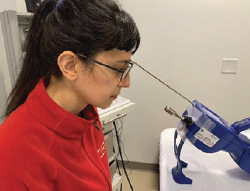Due to the high prevalence of taste disorders as an early clinical symptom in patients with COVID-19, proper screening and evaluation should be performed.
No Correlation Between SARS- CoV-2 Viral Load and Olfactory Psychophysical Scores in COVID-19 Patients
Olfactory dysfunction (OD) presence does not seem to be useful in identifying subjects at risk for being COVID-19 super spreaders.
Nasal Lavage May Be a Valid Alternative to Swab Method in SARS-CoV-2 Detection
Nasal and nasopharyngeal lavages appear to be well tolerated and highly reliable in detecting SARS-CoV-2.
Sleep Apnea an Unrecognized Risk Factor for Mortality in Patients with COVID-19
This analysis highlights the need for close monitoring of patients with sleep apnea who become infected with COVID-19.
Early Tracheotomy Correlated to Shorter ICU Stays in Severe COVID-19 Cases
Early tracheotomy is related to reduced need for mechanical ventilation and shorter ICU stay in severe COVID-19 cases.
Psychophysical Testing of Chemosensory Function During COVID-19 Infection Shows Recovery Trend
Chemosensory dysfunction is very common in COVID-19 and, although most people regain function within the first 28 days.
What Is the Prevalence of Olfactory Dysfunction in COVID-19 Patients?
Evidence indicates that the prevalence of olfactory dysfunction in COVID-19 patients is 48.85%.
Which Otologic Procedures Poses the Greatest Risk of Aerosol Generation?
Significant aerosol levels were generated during cadaveric simulation of mastoidectomy, and aerosol spikes were appreciated during cochlear implantation in live patients.

Office Laryngoscopy Is Not Aerosol Generating When Evaluated by Optical Particle Sizer
Is office laryngoscopy an aerosol-generating procedure (AGP), and how can aerosolizing potentials in invasive otolaryngological interventions be critically assessed?
Emotional Disturbance May Be a Central Nervous System Manifestation of COVID-19
A look at the burden of depressed mood and anxiety in COVID-19 and its associated disease characteristics.